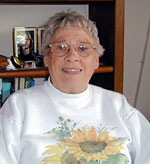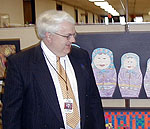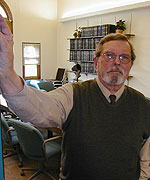By Dan Olson
Minnesota Public Radio
June 3, 2002
Few districts are facing tougher school finance questions than Osseo. The northern Twin Cities school district proposed, then rejected, going to a four-day school week as one way to cope with a nearly $15 million shortfall. Instead, Osseo is cutting staff, raising fees and asking school district residents to pay higher property taxes. Taxpayers rejected the most recent levy increase proposal. School officials may try again this fall.
| |
|
|
|
||
Twenty years ago, Osseo - and many other schools - didn't have classes for teaching basic language skills to non-English speakers. Now, Megan Jasperson and her colleagues teach 1,700 English Language Learner students each day.
Osseo's ELL students come from all over the world. More than 40 languages are represented. Jasperson says the young people have a wide range of English literacy.
"In this class alone we have kids that range from under kindergarten level to beyond fourth-grade level. Probably our highest level student is about eighth grade and yet they are forced, or expected, to achieve in a high school environment," Jasperson says.
Officials expect the number of Osseo's ELL students to double in two years. The cost is relatively modest - only $2 million out of a more than $200 million district budget. Even so, Osseo is hard pressed in a time of budget cutting to cope with more ELL students.
Jasperson's class size is 18. Smaller classes, she says, help students learn faster because conversation with the teacher and other students is easier. Larger classes, Jasperson says, intimidate ELL students.
"They're scared and sometimes they freeze and the learning doesn't happen as well and so I think that is the #1 key is learning from each other and from their teacher," she says.
| |
|
|
|
||
Osseo is Minnesota's fifth-largest school district - 22,000 students. Fifty years ago it was a collection of small towns bounded by farm fields. The district now includes fast-growing suburban cities such as Maple Grove, along with the older, more established communities of Brooklyn Park and Brooklyn Center.
Every year for the past seven, Osseo schools have faced a budget crunch. The shortfall this year is nearly $15 million.
Why the annual budget blues?
District officials say money from the state increased an average of nearly 2.5 percent over each of the past 10 years - roughly the overall rate of inflation, but less than the rate of cost increases for critical expenses such as salaries, health insurance and transportation.
Superintendent Chris Richardson says every sector of the district's operations is feeling the effects of cuts to erase the gap.
"Cuts at the central office level of about 32 percent of our budget, to cuts at the secondary and elementary level of about 10 percent of their budgets," according to Richardson.
Like every district, Osseo's biggest expense is salaries. There are 3,400 Osseo teachers and staff. Richardson says erasing a multi-million dollar budget shortfall means firing workers.
"This year we cut about 207 staff members from our district. That's on top of about 40 staff members that were cut the year before," Richardson says. The result, Richardson says, will be class sizes as large as 40 kids in some rooms.
A few courses have been cut. The extracurricular fee for students who want to play sports or participate in music is $170, rising to $180 next year.
| |
|
|
|
||
Richardson says the district may go back to voters this fall asking to raise property taxes to pay for school operations. Last fall, voters rejected the rate hike.
"Never have we not voted for a school bond referendum," says school district resident Rose Lillestol, who voted for the increase. When her late husband and four children moved into the Osseo school district 43 years ago, they became ardent public school supporters - school carnival, PTA, the works. The kids are grown. Rose Lillestol lives in a comfortable but by no means ostentatious middle class home.
She voted for the Osseo referendum because she assumed state takeover of some public school expenses would result in a property tax break roughly equal to the amount of the proposed levy increase.
However, Lillestol's property taxes declined only $50, much less than she expected. Lillestol says she doesn't know what she'll do this fall when the district asks for a tax increase that on her house could amount to $300 more a year.
"Even though I can, I'm still on a fixed income. I have a pension, and I have Social Security and I have some investment income. But it really is the same year after year except for the little dab you get for a Social Security increase and then your health insurance goes like that and it's gone in a minute," she says.
Osseo superintendent Chris Richardson understands. He faces the same realities. The district's transportation costs are up 3.5 percent, health insurance costs are up 17 percent.
Osseo isn't alone. Around Minnesota dozens of districts face budget problems.
"We're a decade or longer into a national kind of fever that says, 'Read my lips, no new taxes.' Well, that's had a lot of impact on peoples' willingness to support any kind of public services," says Van Mueller, a University of Minnesota emeritus professor of education policy. He's a former classroom teacher, school administrator, and as he freely admits, a staunch supporter of public education.
But his support does not extend to the way education in Minnesota or most other states is financed. It's not equitable, he says. Resource rich districts - Twin Cities suburbs with lots of expensive homes and a big business tax base - have less trouble coping with rising costs. Their students reap the benefit with smaller classes, more offerings.
Osseo and other suburban districts that don't have enclaves of high-end homes or lots of business and commercial real estate are not as well off. Their tax base isn't as deep. They have more middle class, lower middle class and poor taxpayers hard pressed to pay more in taxes.
Mueller says there's a straightforward way to address the imbalance. He says the first step in deciding how much Minnesota should spend on education is to define what we want our public school students to know. Once we decide what Minnesota's 850,000 kindergarten through twelfth graders should learn, Mueller says, we can put a price on the cost of supplying the knowledge.
"We define it, cost it out, and then we figure out a delivery system to get the money out in differential ways to the school districts that need the resources," he says.
Under Mueller's plan more tax dollars go to districts where the need is greatest. A version of his idea is in place. Districts with greater needs get more money. But Mueller's plan goes further, and it creates a political minefield - taxpayers around the state sending money to schools with greater needs.
Soon, Minnesota will hire a consultant to assess what the state is getting for its education spending. Rep. Alice Seagren, R-Bloomington, and chair of the Minnesota House K-12 Education Finance Committee says lawmakers want to know if the money is going to the right place.
"If we're spending money on truancy programs and nothing changes, maybe that'll be something to highlight and to say, 'OK we need to look at this differently. We don't need to keep spending more money on this we need to change what we're doing before we spend more additional,' so I'm hoping as policy maker something will come out of this that will give me an opportunity to examine what we're doing," she says.
There's been plenty of tinkering with Minnesota's school funding. Lawmakers have sometimes voluntarily, sometimes under threat of a lawsuit, altered the system over the past 30 years to equalize spending among districts. They've done so with an eye on the state's constitution which says, "it is the duty of the Legislature to establish a general and uniform system of public schools."
Ideas abound for how to hold the line on Minnesota public education costs. Reformers advocate wider use of charter or private schools, vouchers and cyber learning. But their potential for cost savings and their ability to educate all kinds of children is hotly disputed.
Osseo superintendent Chris Richardson says the near term reality for Minnesota property tax payers is many districts will be asking for more money to cope with the state's education finance crisis.
"I think there'll be a constant effort on the part of school districts to pass levy referendums," Richardson says.
More Information


